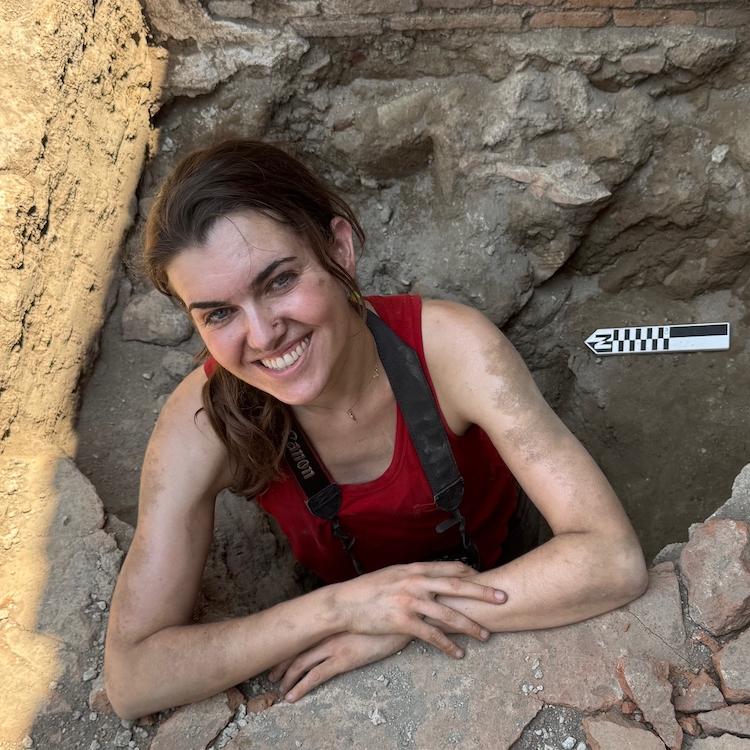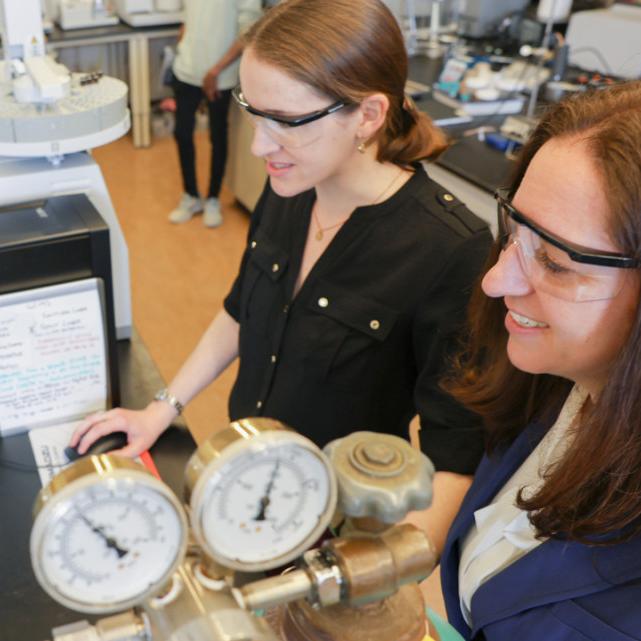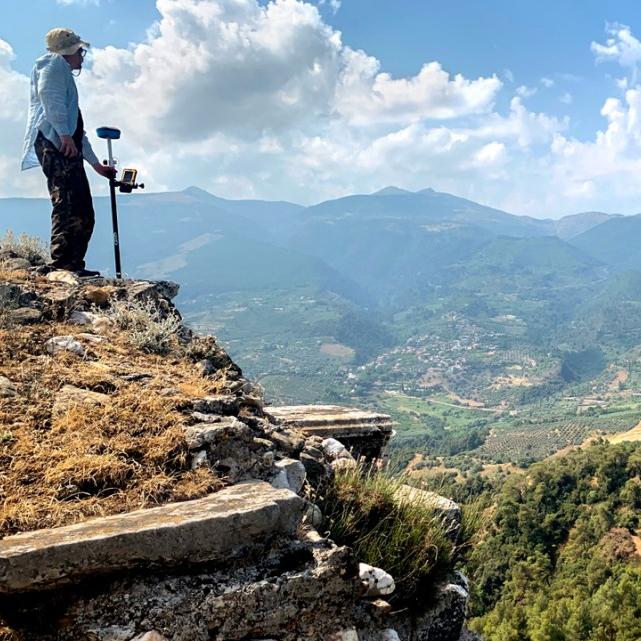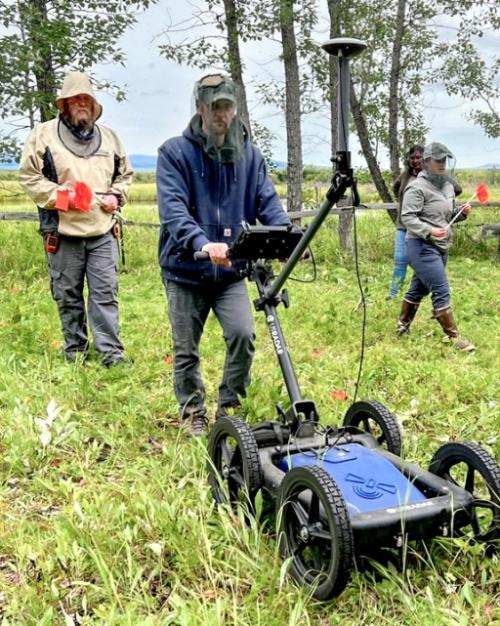A Cornell research scientist, working in partnership with an organization representing a consortium of 20 Native Alaska groups, used ground-penetrating radar and AI modeling to locate the communal graves of approximately 93 victims of the Spanish influenza at Pilgrim Hot Springs on the Seward Peninsula – a finding that helps clarify the historical record for the Indigenous communities devastated by the 1918-19 pandemic.
The project is part of a larger interdisciplinary effort launched through a new five-year Cooperative Ecosystems Study Unit agreement between Cornell and the National Park Service in Alaska that will marshal university expertise to tackle archaeological and environmental issues in the region.
Leading the effort is Thomas Urban, research scientist in the College of Arts and Sciences (A&S), who has been conducting archaeological and paleontological research across the national park system in Alaska for the last decade. That work, under a cooperative agreement with the Department of the Interior’s National Park Service, has ranged from monitoring coastal permafrost loss to using geophysical imaging to locate ancient campsites, a dilapidated ghost town from the Gold Rush era that collapsed into a river and a mammoth skeleton frozen in a tundra lake.
“During fieldwork in Alaska, I’ve sometimes been asked to help Indigenous communities locate unmarked burials using the same noninvasive technologies we’re using to investigate other types of sites,” Urban said. “I tried to assist whenever possible, though this wasn’t always a specified part of project funding. After recent discussions with the park service, we decided this type of community-driven collaboration should become a formal part of our activity in the region in the coming years.”
When it came time to renew their cooperative agreement last summer, Urban sought to enlarge the scope and include university collaborators who could join in planning future projects relevant to their fields. Along with Sturt Manning, Distinguished Professor of Arts and Sciences in Classical Archaeology and director of the Cornell Tree-Ring Laboratory (A&S), and a longtime collaborator on the previous Alaska research, Urban reached out to Kade Keranen, associate professor in the Department of Earth and Atmospheric Sciences in Cornell Engineering, and Kurt Jordan, associate professor of anthropology (A&S) and director of the American Indian and Indigenous Studies Program in the College of Agriculture and Life Sciences.
The three primary focuses of the new group – named the Cornell Arctic Science and Technology Network (CAST-NET) – are environmental monitoring to address threats from global climate change; archaeological research into historical sites; and outreach and collaboration with Native communities.
Research ‘by, with and for’ Indigenous communities
Pilgrim Hot Springs, with its geothermal heat, lush landscape and plentiful wildlife, was historically a treasured resource for Indigenous communities. However, after legislation extended the Homestead Act to Alaska in 1898, Pilgrim Hot Springs was seized, sold and resold among numerous non-Native landowners. In 1917, the springs were deeded to a Jesuit group as a gift for a Catholic mission. The following year, as a mission from nearby Mary’s Igloo was being relocated to Pilgrim Hot Springs, the global Spanish flu pandemic began to ravage the Bering Strait region, disproportionately impacting Native communities. The mission soon expanded to include an orphanage and boarding school to provide care for the region’s surviving children.
“During that time of illness and chaos, many people were buried at Pilgrim, which we now know and have confirmed, but we don’t really know who those people are,” said Amanda Toerdal, who serves as Pilgrim Hot Springs general manager through Kawerak, Inc., one of seven member corporations that comprise Unaatuq, LLC, the company that now owns the springs. (The 1971 Alaska Native Claims Settlement Act set up for-profit Indigenous corporations as the form of governance, rather than tribal nations as in other states).
“One of our priorities for development at Pilgrim Hot Springs is the culture and the history of the site,” Toerdal said. “We knew from documentation from the Catholic diocese and the Jesuit Archives Research Center that there were two large graves on the site from the 1918-19 Spanish flu. That’s something that’s been talked about for decades, but no one was ever really sure of the exact location of those large graves.”
A contact at the Western Arctic National Parklands and Bering Land Bridge National Preserve connected Urban with the project. Over the course of several days last summer, Urban used ground-penetrating radar (GPR) to survey Pilgrim Hot Springs’s fenced-in cemetery – which features very few grave makers – and the surrounding area.
“Ground-penetrating radar has been used to investigate burial sites for a long time,” Urban said. “I have a large database of radar-based burial data, which lent itself very well to developing AI-based approaches to rapidly identify anomalies that are consistent with burials. The hope is that this will expand our capacity by speeding up the process of analyzing data.”
Urban has been collaborating with Iris Technology Inc. to develop several artificial intelligence applications for geophysical data on a newly launched platform called webAI. Among those applications, a model was trained from a large number of burial scenarios for the purpose of efficiently sifting through anomalies in radar data to identify likely burials.
A total of 93 anomalies were ultimately identified to be consistent with human burials.
“It’s really important information to have and to share, as well, for the people of our region,” Toerdal said. “And it’s been an eye-opening experience to see what’s underground.”
The findings will now enable Pilgrim Hot Springs to commemorate where the Spanish flu victims were interred and officially recognize their part of history.
“There have been a lot of Indigenous people who have died in institutions. Obviously, the Spanish flu was devastating for every population, but in terms of actually documenting exactly who had passed away or notifying the Indigenous community members or dealing with their remains in a respectful way – it’s pretty likely that that did not occur,” Jordan said. “I think the Native community is really trying to deal with a long-standing wound, a historical trauma, and in this particular instance they’re using the tools of archaeology – broadly speaking, because archaeology is not just about excavation, it’s also about using noninvasive ways to determine information.”
While archaeologists of the past often conducted research, including the unearthing of human remains, without the input or consent of the descendant communities, the field is much more cognizant now about the importance of working “by, with and for” Indigenous communities, Jordan said.
“I think Tommy’s work here is a really stellar example of research that’s being done in alignment with community priorities,” said Jordan, whose own research has collaborated with members of the Onöndowa’ga:’ (Seneca) and Gayogo̱hó꞉nǫɁ (Cayuga) Nations in New York. “They’re saying exactly what they want to have done, and the data will be in their control. It’s a moment of true partnership.”






